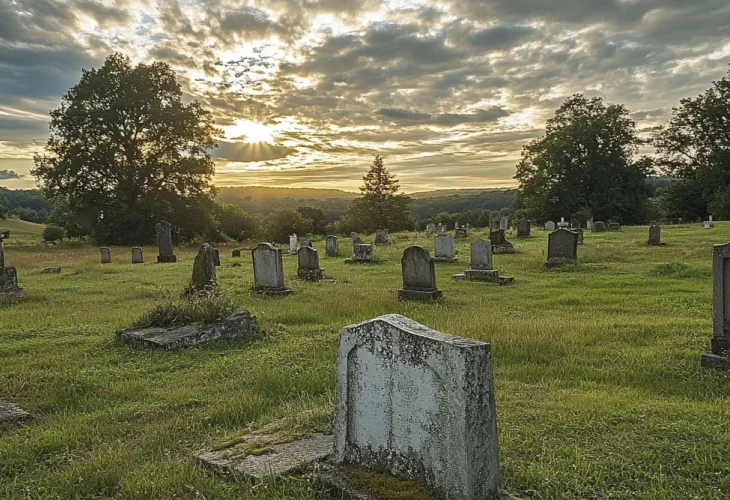The Mystery of Rabbi Nachman's Resting Place: Why Thousands Flock to Uman
Who were the holy martyrs of Uman? Why is Rabbi Nachman buried in Uman instead of his hometown, Breslov?
 An image of an old cemetery with green grass and large stone graves
An image of an old cemetery with green grass and large stone gravesRosh Hashanah is just around the corner, and each year, thousands make their way to Uman, Ukraine. But why is Rabbi Nachman buried in Uman when his life and teachings were centered in Breslov?
Rabbi Nachman requested to be buried in Uman because it is the resting place of many holy Jews who were martyred for sanctifying Hashem's name. His grave is located in the cemetery where these martyrs were once laid to rest. Who were the holy martyrs of Uman?
In 1768, Ukrainian Cossacks rebelled against Polish rule in Ukraine. They were known as the Haidamaks, led by Maxim Zhelezniak. Zhelezniak forged an order supposedly from Empress Catherine II of Russia, claiming that she commanded the Cossacks to massacre Poles and Jews and promised them protection. This false endorsement prompted the Cossacks to act as they wished.
On June 17, the Cossacks laid siege to the city of Uman. After three days of siege, on June 20, the walls were breached. Initially, the Polish nobles fought alongside the Jews (during this battle, the daughter of a Polish noble, Sophia, fell, giving rise to "Sophia Garden" near Rabbi Nachman's tomb), but the Polish commander, Ivan Gonta, decided to join forces with the Cossacks against the Jews. Around three thousand Jews barricaded themselves in the synagogue. The attackers approached and aimed to harm the Jews.
 (Photo: shutterstock)
(Photo: shutterstock)One contemporary chronicler describes: "There was a Jew named Rabbi Leibish of Sharigrod whose blood boiled like a fish frying in a pan, and he seized a sword and killed at least twenty agitators. Another, Moshe the butcher, showed even greater bravery, slaughtering several with his knife."
These were indeed acts of heroism, yet they did not prevail against the attackers. Due to the betrayal by the Polish command, the enemies possessed a cannon, and they bombarded the synagogue, killing hundreds in the first barrage. The attackers offered those trapped inside a chance to live if they converted to Christianity, setting up a small gate and declaring: anyone who passed through the gate would convert and be saved. But none of the Jews chose to save their lives at the cost of their faith.
The Cossacks brutally massacred everyone. Another historian recounts: "The marauders caused great slaughter in the study hall, with blood flowing beyond the thresholds. Afterwards, they took out all the Torah scrolls from the synagogue and study hall, spread them in the streets, and trampled them under their horses' hooves."
Outside the city, the Cossacks encountered Jewish wagons trying to flee and killed everyone. However, fifty Jews managed to survive by hiding in a cave with a tzaddik named Rabbi David Chazan, whom the Baal Shem Tov had foretold would "save fifty Jews."
Thousands of Jews were slaughtered in this massacre. Opinions vary on the exact numbers. The marauders continued to lesser-known towns in the area, but the Uman massacre is remembered as particularly savage.
Following the massacre, the authorities tried leading perpetrators. The Polish commander Gonta was sentenced to death by Poland's monarchy and immediately executed with torture. Zhelezniak was judged by the Russian Empress, whose command he had forged, and sentenced to life in Siberia with hard labor. Yet for the slain Jews martyred for Hashem's name, this justice came too late.
Special elegies were composed for this tragedy. Rabbi Avraham Epstein wrote in his lamentation: "Land, do not cover their blood, and let there be no place for their cry. Until Hashem will look and see from heaven and avenge His vengeance and the vengeance of His people and His Torah and the blood of His servants spilled like water."
Rabbi David Chazan also composed a lamentation for the massacre, and the 5th of Tammuz was commemorated in Uman as a fast day.
Rabbi Nachman of Breslov, who was born four years after the massacre, requested to be buried among the martyrs of Uman, declaring, "This is a good place to lie." His wish was fulfilled, and he was laid to rest among them, allowing the martyrs to be visited by all the chassidim who come to Rabbi Nachman's grave.
This is what is recorded in Chayei Moharan: "He greatly extolled the praises of Uman's cemetery, for there lie many holy thousands and myriads. There was a great martyrdom for Hashem's name at that place. He often said explicitly, and before many others, that it was good for him to lie there, because there was a great sanctification of Hashem's name there. Eventually, all his statements were fulfilled, and he passed away in Uman, in the home of the individual who gave him lodging, as above, so they all saw and marveled and understood that his primary purpose in coming to Uman was to pass away there, as was heard explicitly from his mouth many times.
"Regarding his stay in Uman, one's ear cannot be filled with hearing all he did there during that summer. What we have heard is but a small drop in the ocean, glimpsed through our understanding from the hints heard from his mouth. For there he performed awesome, wondrous, sublime acts of tikkun, engaging significantly in the rectification of souls, as understood from the little tale he told us when he entered there."

